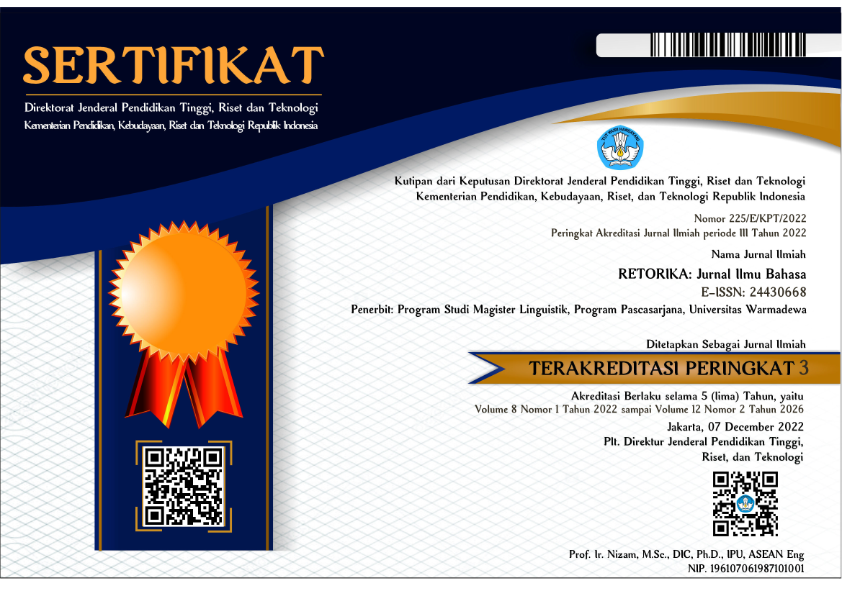Use of Indonesian Language in Space Outside Media in City of Timika
Abstract
The strategic position of the Indonesian language for the Indonesian people is reflected in the third pledge of the Youth Pledge in 1928 which reads "We sons of Indonesia uphold the united language of Indonesian" and the 1945 Constitution Article 36 which states that "the language of the country is Indonesian". The aim of the study was to describe the use of Indonesian in outdoor media in the City of Timika. This study is focused on spelling mistakes, misuse of word choices, and sentence errors. The method used in this study is descriptive qualitative method and prescriptive technique, namely by describing and explaining the findings in the field and providing solutions to the problems found in the use of Indonesian in public spaces in Timika City. The results of this study showed that the forms of errors found in the use of Indonesian in the public area are spelling error, punctuation error, and writing error in absorption elements. The form of spelling errors consists of the use of letters, use of diphthong letters, use of capital letters, consonant combined letter, use of words, basic word, the word affix, reshape, word combination, preposition, abbreviations and acronyms. Meanwhile, the form of punctuation error consists of dot, commas, colon, hyphen, dash, exclamation mark, quotation mark, brackets, and italic line. Furthermore, the form of writing error in absorption elements consists of the use of sentences and words choice. In conclusion, there are still some errors found in public spaces in Timika city.
References
Alhaisoni, E. M., Al-Zuoud, K. M., & Gaudel, D. R. (2015). Analysis of Spelling Errors of Saudi Beginner Learners of English Enrolled in an Intensive English Language Program. English Language Teaching, 8(3), 185–192. Retrieved from https://files.eric.ed.gov/fulltext/EJ1075204.pdf
Alwi, H., Lapoliwa, H., & Darmowidjojo, S. (2003). Tata Bahasa Baku Bahasa Indonesia (Edisi Ketiga). Jakarta: Balai Pustaka. Retrieved from https://www.goodreads.com/book/show/1773460.Tata_Bahasa_Baku_Bahasa_Indonesia
Chaer, A., & Agustina, L. (2004). Sosiolinguistik: Perkenalan Awal. Jakarta: Bhineka Cipta.
Finoza, L. (2001). Komposisi Bahasa Indonesia. Jakarta: Insan Mulia.
Keraf, G. (2002). Diksi dan Gaya Bahasa. Jakarta: PT Gramedia Pustaka Utama. Retrieved from https://books.google.co.id/books?id=2zm9pAbUHP8C&printsec=frontcover#v=onepage&q&f=false
Mahsun. (2005). Metode Penelitian Bahasa. Jakarta: PT Raja Grafindo Persada.
Rusvid, A. R., Saun, S., & Fitrawati. (2016). An Analysis on Spelling Errors Made by the Second Grade Students of Office Administration Department of SMK N 3 Padang in Writing a Personal Letter. Journal of English Language Teaching, 5(1). Retrieved from http://ejournal.unp.ac.id/index.php/jelt/article/view/7258/5691
Sugono, D. (2008). Berbahasa Indonesia dengan Benar. Edisi Revisi. Jakarta: Puspa Swara.
Tarigan, D., & Sulistyaningsih, L. S. (1997). Analasis Kesalahan Berbahasa. Jakarta: D. Jakarta: Direktorat Jenderal Pendidikan Dasar dan Menengah.
Copyright (c) 2020 RETORIKA: Jurnal Ilmu Bahasa

This work is licensed under a Creative Commons Attribution-ShareAlike 4.0 International License.
This journal provides immediate open access to its content on the principle that making research freely available to the public supports a greater global exchange of knowledge.
All articles published Open Access will be immediately and permanently free for everyone to read and download. We are continuously working with our author communities to select the best choice of license options, currently being defined for this journal as follows: Creative Commons-Non Ceomercial-Attribution-ShareAlike (CC BY-NC-SA)
 Abstract viewed = 252 times
Abstract viewed = 252 times
 PDF downloaded = 644 times
PDF downloaded = 644 times

2.png)














